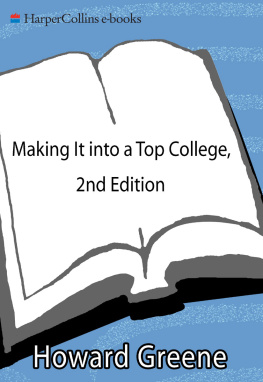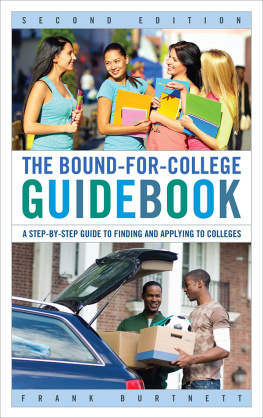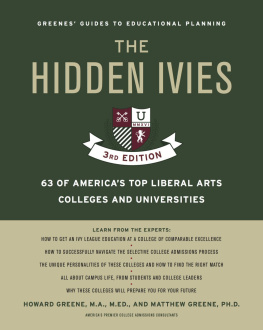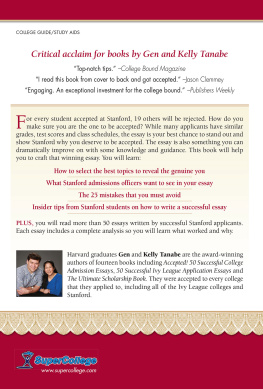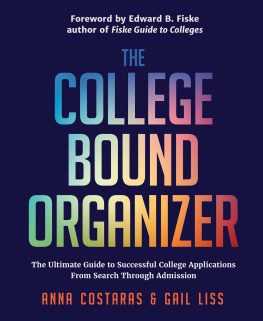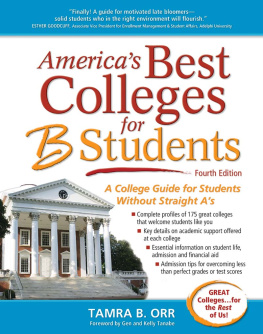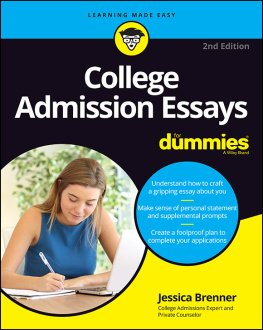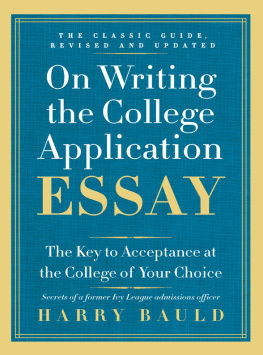ADMIT ONE
ADMIT ONE
WRITING YOUR WAY INTO THE BEST COLLEGES
Thomas Richards

2019 Johns Hopkins University Press
All rights reserved. Published 2019
Printed in the United States of America on acid-free paper
9 8 7 6 5 4 3 2 1
Johns Hopkins University Press
2715 North Charles Street
Baltimore, Maryland 21218-4363
www.press.jhu.edu
Library of Congress Cataloging-in-Publication Data
Names: Richards, Thomas, 1956 author.
Title: Admit one : writing your way into the best colleges / Thomas Richards.
Description: Baltimore : Johns Hopkins University Press, 2019. | Includes index.
Identifiers: LCCN 2018033809 | ISBN 9781421428642 (paperback : alk. paper) | ISBN 1421428644 (paperback : alk. paper) | ISBN 9781421428659 (electronic) | ISBN 1421428652 (electronic)
Subjects: LCSH: College applicationsUnited States. | Universities and collegesUnited StatesAdmission. | Exposition (Rhetoric) | EssayAuthorship.
Classification: LCC LB2351.52.U6 R53 2019 | DDC 378.1/616dc23
LC record available at https://lccn.loc.gov/2018033809
A catalog record for this book is available from the British Library.
Special discounts are available for bulk purchases of this book. For more information, please contact Special Sales at 410-516-6936 or .
Johns Hopkins University Press uses environmentally friendly book materials, including recycled text paper that is composed of at least 30 percent post-consumer waste, whenever possible.
For my daughters: Rachel and Rebekah
PREFACE
THIS BOOK is intended for students who need to write well to get into college. It offers in a brief space a complete course in the elements of composition needed for students to present themselves with clear-edged precision to an application committee. It covers the essentials of writing, by which I mean the methods by which a writer can use good seeing, feeling, and thinking to represent himself or herself in three dimensions in prose. For college admissions, this almost always means writing in the first person about things from the world of a writers own experience. It also means beginning to find an orderliness in that experience that lends itself to vivid expression in narrative. But good narratives do not come out of nowhere. They have to be found, and the various means by which good narratives can be found, developed, and extended are the subject of this book.
A college application is first and foremost a narrative about the person writing it. Students can often recognize good narratives when they read them, but they are often weak in understanding their component parts. Much of this book is taken up with explaining how good narratives fit together and how the unity of narrative can also be used to unify a college application. Understanding how good narratives fit together means studying examples in detail, which I do. Narratives have an integrated voice. Students are often encouraged to find their own voice, but they are only infrequently told how hard it is to find it on their own. The great English painter Sir Joshua Reynolds once said, the more extensive your acquaintance is of the works of those who have excelled, the more extensive will be your powers of invention. An inventive college essay does not come out of a vacuum but is the carefully constructed result of choices a writer has made, one by one. This quality of self-awareness in self-expression is one of the things colleges are looking for in applicants. It involves knowing what one is saying and understanding where what one is saying comes from.
A strong application also involves a sense of overall design. Most college applications do not fit together very well. Many students want to put as much information as possible about themselves in their applications, but much of what they set down seems closed off from who they actually are. They are full of common outer experiences whose inner meaning the writer seems to regard as self-evident. And they are full of common ambitions whose ends and aims the writer seems to regard as self-justifying. As writers, many students have not yet learned to attach words to experience with any accuracy of import or meaning. The result is an application that often reads like a series of questions to answers on a test. There is simply no sense of a unified person behind the words. It then becomes perilously easy for a reader to see the writer as nothing more than a series of glimpses and anecdotes. In everyday life, we constantly piece together images of people from limited evidence. But in a college application, such a fragmentary treatment has a very good chance of being rejected.
Many people try to teach students how to write admissions essays. This book teaches students how to write by writing the admissions essay. This is not a general handbook of rules for composition but a method for composing one particular kind of essay. I try at every point to give students the power of choice over how to represent themselves. Most admissions essays rely on standard forms of self-representation played out in preformed, widely shared narratives. I have tried to work out a method to free students from the crushing regularity of these narratives, discovering a means of expression that comes closest to how they actually see themselves. Writing well means being open to their own experience, whatever it is, their sense impressions, their memories, and their feelings about them, and all the learning they have come to carry around with them after years of schooling. Writing well also means being open to the experience of studying great writings, selected to show them the beginnings of a way forward. The resulting essay comes as close as possible to being a trustworthy representation of a whole person at a moment in time.
But not just at a moment in time. Many college application essays present frozen selves and do not account for all the pulls and forces that make a person complex. Here is where, coming to this work, I felt I had a special training. I am a novelist and literary critic. I have spent my life trying to understand why some representations of life and character are vivid, while others are wanting. Novels and short stories show the development of character over time, responding to the pressure of events. They can be studied in and of themselves, but they can also be used as models for how to present character in a rounded way. In Aspects of the Novel, E. M. Forster speaks of flat and round characters. A flat character is one who is easily recognized whenever they come in. This is because they are constructed around a single idea or quality. A round character is one who is multidimensional. Most admissions essays suffer from the problems of flat characters in fiction. They never develop. But they suffer from another problem as well. In fiction, flat characters rarely pose as round characters. In most admissions essays, a flat character is being presented as round, usually because the writer is unaware of the means by which a rounded character is created in prose. The flatness can have many sources. There can be a flatness in language, but there can also be a flatness in observation, emotion, or thought. I will cover these forms of flatness in detail later. What matters here is that, as Forster says, except for one governing impulse, the flat character has no existence outside it. In an admissions essay, this limiting impulse may be a typical ambition (becoming a doctor or lawyer) or a common activity (belonging to a team or an organization). They are easily remembered, but for all the wrong reasons, for they are never changed by circumstances and are often close to caricature.
Next page

